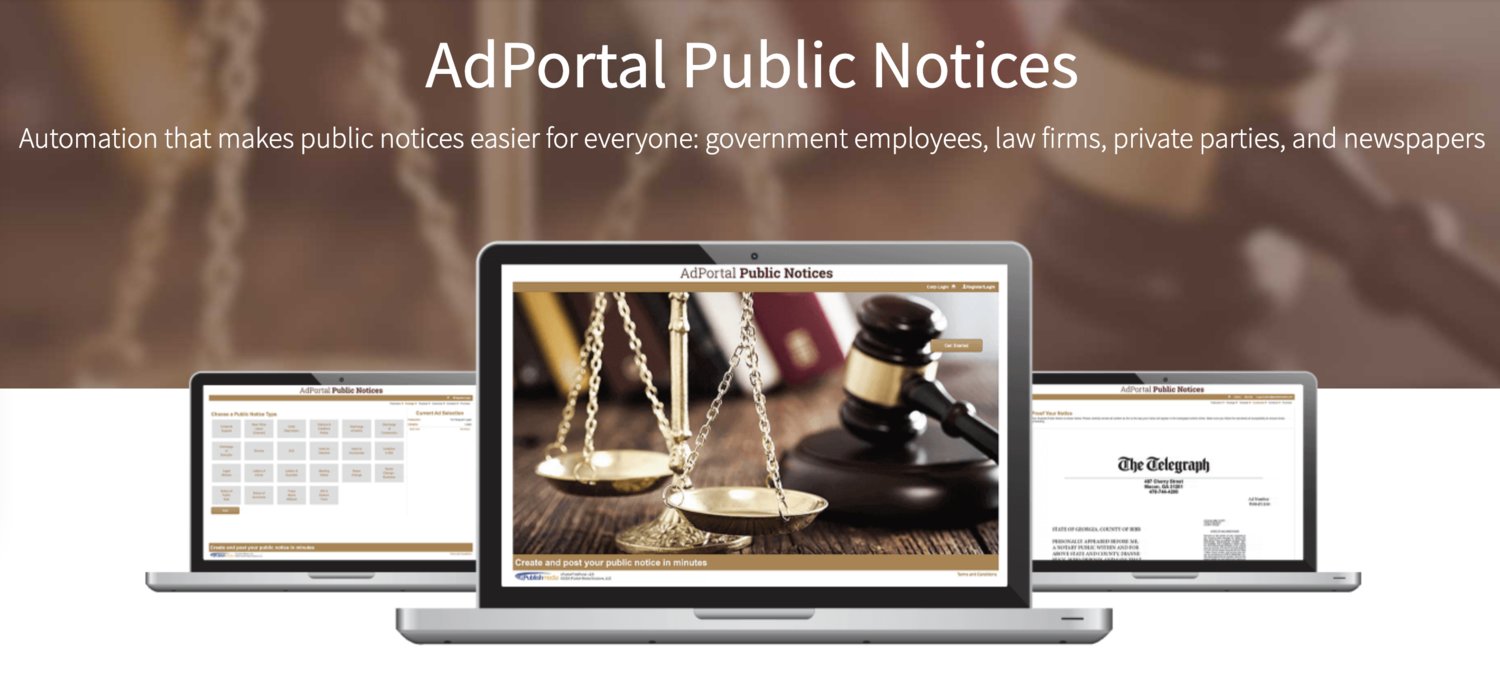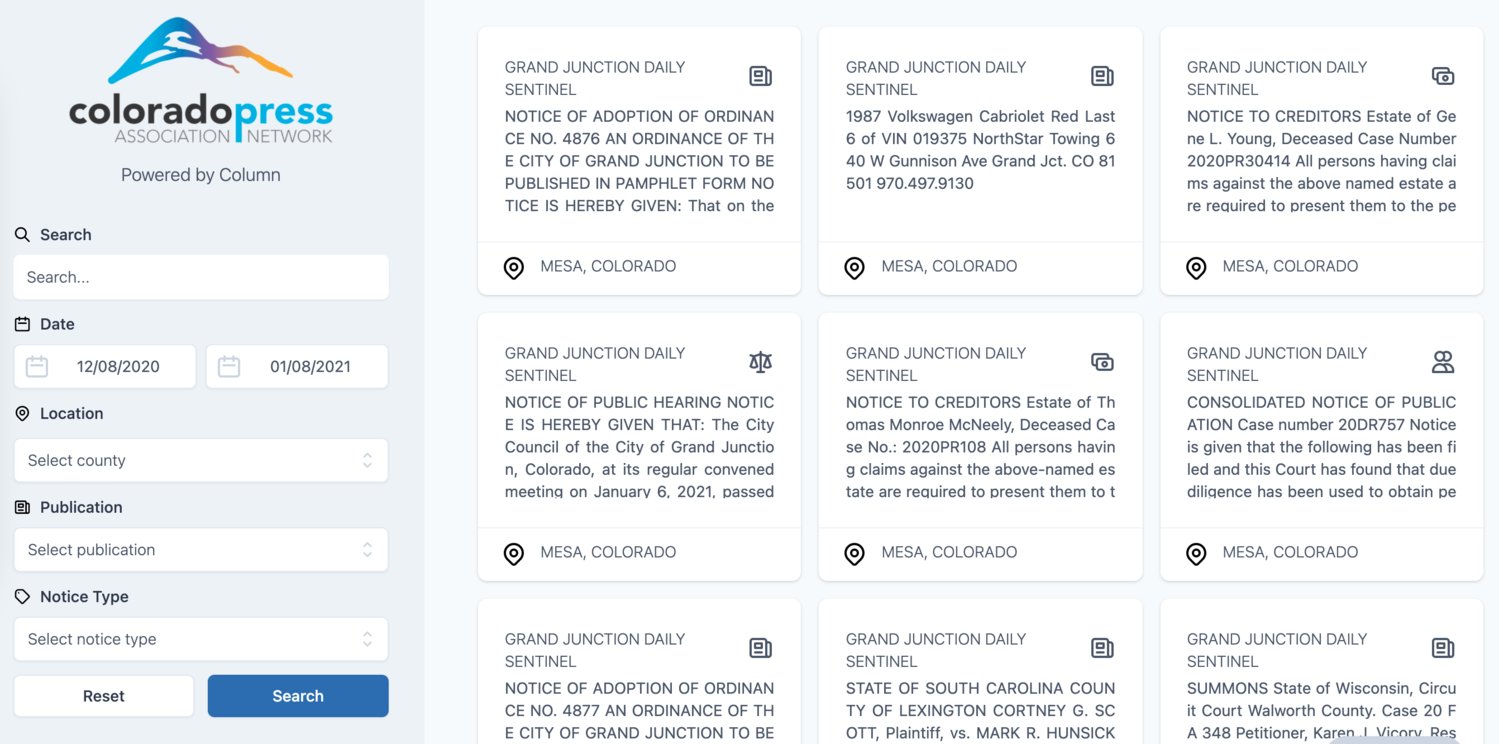Technology modernizes public notices
A closer look at two companies bringing public notices into the future
An increasing number of newspapers will modernize how public notices are published in 2021.
It’s a good thing. Most newspapers are adjusting to relentless economic pressure, and public notices have been a stable source of revenues, critical to survival for some companies.
Meanwhile, state legislatures’ ongoing battles against requirements are sure to continue this year. Modernizing the franchise makes the case for newspapers that much stronger.
Simplified order-taking, searchability, and data visualization also promise to add improvements in usefulness for the first time in decades.
The leading technology company in this re-invigorated space is iPublish Media Solutions, which specializes in self-serve advertising software, and was acquired by Legacy in 2019. The agile software company has processed hundreds of millions in transactional revenues.
Meanwhile, newcomer, Column, founded by CEO Jake Seaton in 2019, says it has onboarded dozens of publications, including the Washington Post, with a similar model.
The idea that certain types of notices - from public meetings to foreclosures - should not only be published but also “pro-actively distributed”, dates back to 200-year-old British legal tradition, said Seaton, member of a 5th generation newspaper family.
Over the years, however, requirements to publish notices like bankruptcies and building permits as raw data in print became seen as a boondoggle for newspapers, while some governments contending with complicated paperwork and requirements, began to see them as a nuisance.
Attitudes may change, however, as newspapers modernize public notice entry, and re-imagine public notices data as a public service.
So just who actually uses public notices today?
Realtors and contractors identifying new prospects. Citizens who want to buy homes at auction, or check if a home is at risk of foreclosure. People searching for unclaimed tax refunds. Businesses tracking local procurement opportunities. Reporters looking for hyper-local trendlines formerly buried in the data. Plus anyone double-checking the latest Covid ordinance or the date of a public meeting. Some Public Meetings are now available via a Zoom link, so anyone can join.
With information stored in a database, searchability makes all these activities much easier, driving traffic to the newspaper site.
iPublish Media, the 14-year-old company and self-serve advertising veteran, has a built-in head-start with some forty newspapers already using their automated public notice front end. They can build on solid relationships with a number of local media super-powers, like Gatehouse, Boston Globe, Utah Media, and Bay Area News Group.

Full disclosure: iPublish is a content-marketing client of LMI. The company’s top categories, Obituaries and Real Estate, already use end-to-end tools that auto-build ads, take payments, and distribute to print and digital. iPublish Public Notice software runs on top of the super-stable core platform.
Sally Steed, VP of advertising at Utah Media Group, which implemented the public notices platform in 2019, told the audience at a virtual LMA conference that the initiative has been a home run.
“I can’t say enough good about how much easier it is to enter (notices). People feel like they are in control,” Steed said.
Another benefit was pointed out by Ed Woods, VP and CRO of Media News Group NE, at the same conference: Municipalities have shown they are interested in avoiding the need to collect payments because cards are stored in the system. He plans to launch public notices on the platform early this year.
Column has also planted its own flag in the franchise. The company originally installed the software to transform public notices on a family-owned newspaper, the Manhattan Mercury, circulation 50,000, in February 2020 after a year spent on development.
Family connections morphed into the company’s relationship with the Washington Post - editor Marty Baron is an informal advisor - and eventually a demo with the classified department. Since Column is based in D.C., the Washington Post is actually its “local paper,” Seaton noted. Still landing the Washington Post is an astonishing coup for a first-year company.
Unlike iPublish Media which charges a licensing fee, Column’s revenue model is to add a percentage of the sale as a service fee paid by the government agency or private party customer placing the notice, so the newspaper itself has “no out-of-pocket expense,” Seaton said.
He plans to focus exclusively on public notices in the years ahead.
Both platforms streamline the process. Complex local mandates such as font size and number of days published are pre-entered into the system one time. Then any end-user from an admin to a lawyer or government agency can input, create a pre-designed ad, receive a proof, and pay online.
Affidavits still require a physical signing, but auto-sign is on the roadmap.
Data-in also means data can come out.
As part of its marketing strategy, Column has provided software free to press associations in Kansas, Colorado and, as of December, New Mexico, to feed public notice data into a searchable statewide database. The public then has an easier way to search the accumulated data. There is even a state-wide map to search basic areas.

So, can technology make public notices sexy again as a new traffic driver for newspapers as well as a utilitarian function for citizens?
The future certainly looks promising. Meanwhile, the industry is off to a great start.





